Calibrate route helps ensure the correctness of measurement values, thereby guaranteeing precise event positioning. Calibrating the measure values of route data using reliable reference point data is a crucial step in dynamic segmentation. For example, the measure values of highway route data represent mileage information, which may lack accuracy. After field surveyors recollect data by taking measurement points every 200 meters along the highway and recording corresponding mileage values through instruments, this newly collected data can serve as reference points to calibrate existing highway route data, ensuring the accuracy of subsequent dynamic segmentation results.
Process of Calibrate Route
Calibrate route is the process of adjusting route measure values by reading reference point measurements. The process is described as follows:
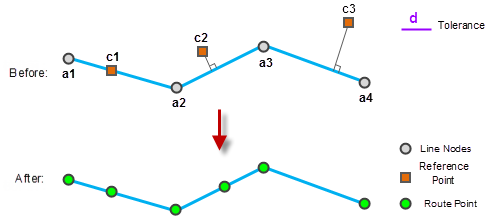 |
| Figure: Schematic Diagram of Calibrate Route |
- Correspond reference points to routes through the route identifier field. Both reference point data and route data contain a route identifier field. Reference points sharing the same identifier as route data are considered matched.
- When a corresponding reference point coincides with a route node, the M-value of that node adopts the reference point's M-value.
- For route nodes not overlapping with reference points, their M-values are interpolated using reference points within the calibration tolerance range.
- Reference points outside the calibration tolerance range will not participate in calibration.
Calibration Methods
The application provides two calibration methods: Calibrate by Distance and Calibrate by Measure.
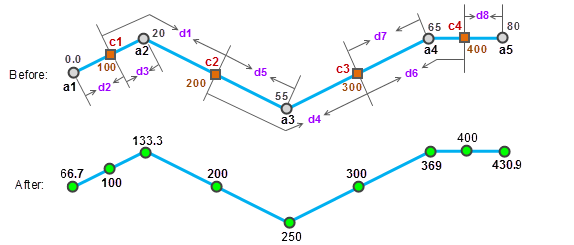 |
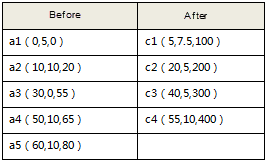 |
| Figure: Schematic Diagram of Calibrate by Distance | |
Calibrate by Distance procedure:
This method uses reference points' measure values at corresponding route positions for calibration, preserving the original route data's measure variation patterns (e.g., incremental, decremental, or abrupt changes). Particularly effective for fine-tuning route measures when the ratio between route length and measure values varies.
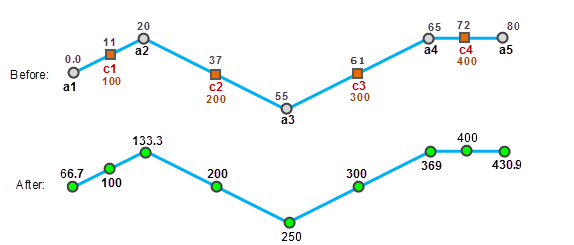 |
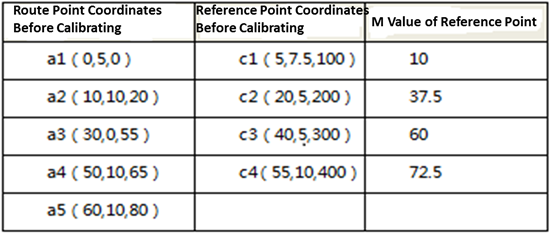 |
| Figure: Schematic Diagram of Calibrate by Measure | |
Calibrate by Measure procedure:
- Calibrate by Distance
Calculates M-values based on the distance along the route between two points. This method produces monotonic calibration results where adjusted M-values are either increasing or decreasing.
- For node a1, use c1 and c2 for calibration. First calculate distance d1 between c1 and c2, then compute calibration rate R1=d1/(200-100). All mentioned distances refer to route-aligned distances.
- Calculate distance d2 between a1 and c1. The equation d2/(100-Ma1)=R1 yields the calibrated M-value: 100 - d2/R1.
- Similarly, calibrate a2 using c1 and c2. Calculate distance d3 between c1 and a2. Using calibration rate R2=d1/(200-100), the equation d3/(Ma2-100)=R1 gives the calibrated M-value: 100 + d3/R1.
- Following this logic: Use c2 and c3 to calibrate a3, c3 and c4 for a4 and a5. Note: Calibration rates are always calculated using the two nearest reference points to the calibrated node.
- The calibrated M-values of route nodes are shown in the right diagram.
- Calibrate by Measure
- Calibrate node a1 using reference points c1 and c2. Calculate calibration rate R1=(37.5-10)/(200-100), where (37.5-10) represents the original line measure difference between c1 and c2.
- The accurate measure difference between a1 and c1 is (10-0). The equation (10-0)/(100-Ma1)=R1 gives the calibrated M-value: 100 - (10-0)/R1.
- Calibrate a2 using c1 and c2. Compute calibration rate R2=(37.5-10)/(200-100). With measure difference (20-10) between a2 and c1, the equation (20-10)/(Ma2-100)=R2 yields the calibrated M-value: 100 + (20-10)/R2.
- Following this pattern: Use c1 and c2 for a2, c2 and c3 for a3, c3 and c4 for a4 and a5.
- The calibrated M-values of route nodes are shown in the right diagram.
 Notes:
Notes:Both calibration methods require at least two reference points for calibration. In both cases, the two nearest reference points to the node being calibrated are used for calculation.



